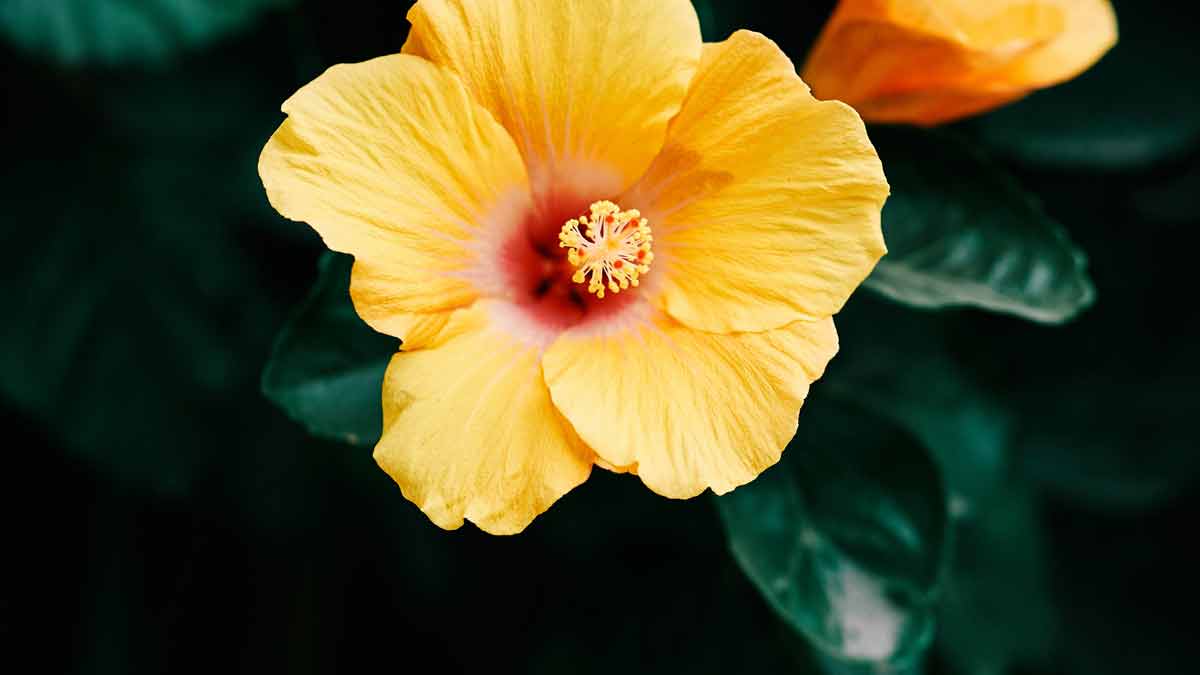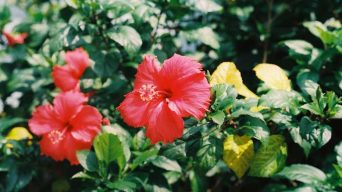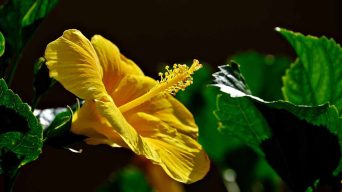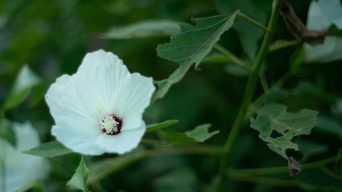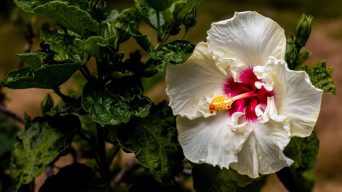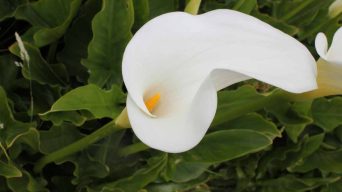Hibiscus leaves turning white can result from issues like powdery mildew, sunburn, low light, nutrient deficiencies, pest infestations, water quality, or temperature stress. To address it, improve lighting, maintain proper watering and fertilization, and protect from pests and extreme temperatures.
Hibiscus plants are beautiful flowering shrubs popular in many gardens and as houseplants.
They come in a wide range of colors and varieties and are relatively easy to care for.
However, hibiscus plants can sometimes experience problems, including leaves that turn white.
There are a few different reasons why this might happen, and luckily, there are also a few solutions.
If you notice your hibiscus leaves turning white, read on to learn more about the causes and how to fix them.
Why Is My Hibiscus Turning White and How Do I Fix It?
There are a few different reasons why hibiscus leaves might turn white.
The most common reasons are listed below, along with solutions for each.
1. Powdery Mildew
Powdery mildew is a type of fungal disease that affects a variety of plants, including hibiscus.
It manifests as a white, powdery substance on the leaves and stems of the plant.
Powdery mildew is most commonly caused by too much moisture or not enough light.
Powdery mildew thrives in humid environments. So, if you live in an area with high humidity or water your hibiscus too often, that could be the cause.
Not enough light can lead to powdery mildew because the plant cannot dry off properly.
How To Tell If Your Hibiscus Has Powdery Mildew
If you think your hibiscus might have powdery mildew, look for the following signs:
- White, powdery substance on leaves and stems
- Yellowing or wilting leaves
- Stunted growth
If you see any of these signs, you must take action immediately. Powdery mildew can spread quickly and is tough to remove once it takes hold.
How To Treat Powdery Mildew On Hibiscus
If your hibiscus has powdery mildew, there are a few things you can do to treat it.
First, try to increase the amount of light the plant is getting. If possible, move it to a spot where it will get more sunlight.
You can also try increasing air circulation around the plant by placing a fan near it or moving it outdoors.
Another way to treat powdery mildew is by using a natural fungicide. You can make your own fungicide by mixing 1 part baking soda with 9 parts water.
Spray the mixture on the affected leaves and stems and coat them thoroughly.
You should also try to reduce the amount of moisture the plant is getting. Water only when the soil is dry to the touch, and ensure the plant has good drainage.
You may also want to reduce the humidity around the plant by using a dehumidifier or moving it to a drier location.
2. Sunburn
Too much sun can cause the leaves of hibiscus plants to turn white.
Hibiscus plants need some sun to thrive, but too much sun can be damaging.
The leaves can get sunburned if the plant is in direct sunlight for too long. This will cause them to turn white or pale yellow.
Hibiscus plants need at least 4 hours of sunlight per day, but they can tolerate up to 8 hours.
If you live in a hot climate, it’s best to place your hibiscus where it will get morning sun and afternoon shade.
How To Tell If Your Hibiscus Has Sunburn
If you think your hibiscus might have sunburn, look for the following signs:
- The leaves are turning white or yellow
- The leaves are wilting
- The leaves are dry and crisp
- The leaves are falling off
If you see any of these signs, you must take action immediately. Sunburn can damage the plant and make it more susceptible to other problems.
How To Treat Sunburn On Hibiscus
If your hibiscus has sunburn, there are a few things you can do to treat it.
First, move the plant to a spot where it will get less sun. If possible, place it in an area where it will get morning sun and afternoon shade.
If grown indoors, you can try moving it to a spot where it will get indirect sunlight. An east- or west-facing window is a good option.
You can also try to increase the humidity around the plant by misting it with water or using a humidifier.
3. Low Light Conditions
Hibiscus plants need a minimum of 4 hours of sunlight per day, but they can tolerate up to 8 hours.
The leaves will turn white if the plant isn’t getting enough light. This is because the plant cannot produce chlorophyll, which gives leaves their green color.
Low light conditions can also cause the leaves to become pale or yellow.
How To Tell If Your Hibiscus Isn’t Getting Enough Light
If you think your hibiscus isn’t getting enough light, look for the following signs:
- The leaves are pale or yellow
- The plant is growing taller and leggier than normal
- The stems are thin and weak
- The flowers are small and few in number
If you see any of these signs, you must take action immediately. Hibiscus plants need 4 hours of sunlight per day to thrive.
How To Increase The Light For Your Hibiscus
If your hibiscus isn’t getting enough light, you can do a few things to increase the amount of light it’s getting.
If possible, move the plant to a spot where it will get more sunlight. An east- or west-facing window is a good option.
You can also try using grow lights. Grow lights are designed to give plants the light they need to grow.
4. Nutrient Deficiencies
Hibiscus plants need a well-balanced fertilizer to thrive. If the plant isn’t getting enough nutrients, it will show signs of stress.
One of the first signs of a nutrient deficiency is the leaves turning white. This is because the plant cannot produce chlorophyll, which is responsible for the green color of leaves.
Nutrient deficiencies can be caused by several things, including poor soil quality, inadequate fertilization, and improper watering.
How To Tell If Your Hibiscus Has A Nutrient Deficiency
If you think your hibiscus has a nutrient deficiency, look for the following signs:
- The leaves are pale or have white patches
- The leaves are small and stunted
- The plant is not growing as quickly as it should be
- Flowers are small or nonexistent
If you see any of these signs, you must take action immediately. Nutrient deficiencies can cause severe damage to hibiscus plants.
How To Fix A Nutrient Deficiency In Hibiscus
If your hibiscus has a nutrient deficiency, there are a few things you can do to fix it.
First, try to improve the quality of the soil. If you’re growing hibiscus in potting soil, consider switching to a higher quality mix.
You can also try fertilizing the plant with a well-balanced fertilizer. Be sure to follow the instructions on the package.
Over-fertilizing can be just as harmful as under-fertilizing, so using the right amount of fertilizer is essential.
You can also add compost to the soil to improve its quality. Compost is an excellent source of nutrients for hibiscus plants.
5. Pest Infestation
Hibiscus plants are susceptible to several pests, including aphids, thrips, whiteflies, and mealybugs.
If your hibiscus has a pest infestation, the leaves will start to turn white. This is because the pests are sucking the sap from the leaves, which prevents the plant from producing chlorophyll.
Pest infestations can also cause the hibiscus leaves to turn yellow, brown, or black. In severe cases, the plant may drop its leaves entirely.
How To Tell If Your Hibiscus Has A Pest Infestation
If you think your hibiscus has a pest infestation, look for the following signs:
- The leaves are covered in small, black, brown, or white insects
- The leaves are turning yellow, brown, or black
- The plant is losing leaves
- The stems are covered in webbing
- The leaves are covered in a sticky substance
If you see any of these signs, you must take action immediately. Pest infestations can cause severe damage to hibiscus plants.
How To Get Rid Of Pests On Hibiscus
If your hibiscus has a pest infestation, you can do a few things to get rid of the pests.
First, try to remove the pests by hand. This is especially effective for small infestations.
Use a soft cloth or cotton swab to remove the pests from the leaves gently. You can also use a spray bottle filled with water to wash the pests off the leaves.
If the infestation is severe, you may need to use a natural pesticide. Neem oil is a good option.
You can also try using yellow sticky traps to catch the pests. Place the traps near the plant so the pests will be attracted to them.
Be sure to check the traps regularly and dispose of the pests properly.
6. Water Quality
If the water you’re using to water your hibiscus is of poor quality, it can cause the leaves to turn white.
This is because the chemicals in the water can build up in the soil and eventually make their way into the plant.
Tap water is usually the culprit. It can contain high levels of chlorine, fluoride, and other chemicals that can harm hibiscus plants.
How To Tell If The Water You’re Using Is harming Your Hibiscus
If you think the water you’re using is harming your hibiscus, look for the following signs:
- The leaves of the plant are turning yellow or brown
- The tips of the leaves are turning brown or black
- The plant is not growing as vigorously as it should be
- The flowers are not as vibrant as they should be
If you see any of these signs, you must take action immediately. Water quality can have a severe impact on the health of hibiscus plants.
How To Improve The Quality Of The Water You Use To Water Your Hibiscus
If you think the water you’re using is harming your hibiscus, you can do a few things to improve the water quality.
One option is to use filtered water. This will remove any chemicals or impurities from the water.
Another option is to collect rainwater and use that to water your indoor plants. Rainwater is pure and free of chemicals.
You can also let tap water sit for 24 hours before using it to water your hibiscus. This will allow the chemicals in the water to dissipate.
7. Temperature Stress
Hibiscus plants are tropical plants, and they prefer warm temperatures.
If the temperature drops too low, it can cause the plant’s leaves to turn white.
This is because the cold weather damages the cells in the leaves.
Temperature stress can also cause the hibiscus leaves to turn yellow, brown, or black. In severe cases, the plant may drop its leaves entirely.
How To Tell If Your Hibiscus Is Suffering From Temperature Stress
If you think your hibiscus is suffering from temperature stress, look for the following signs:
- The leaves of the plant are turning white
- The leaves of the plant are turning yellow, brown, or black
- The plant is dropping its leaves
- The plant looks wilted
If you see any of these signs, you must take action immediately. Temperature stress can seriously damage hibiscus plants.
How To Protect Your Hibiscus From Temperature Stress
If you think your hibiscus is at risk of temperature stress, you can do a few things to protect it.
One option is to move the plant indoors. This will protect it from any cold weather.
Another option is to cover the plant with a frost cloth or blanket. This will provide some insulation and protect the plant from the cold.
If you live in an area with severe cold weather, you may need to take additional measures to protect your hibiscus.
You can use a space heater to keep the plant warm, or you can grow the plant in a greenhouse.
How To Prevent Hibiscus Leaves from Turning White
Prevention is always better than cure.
Here are some tips to keep your hibiscus leaves healthy and prevent them from turning white.
1. Water Your Hibiscus Regularly
Hibiscus plants need to be watered regularly, about once a week.
Water your hibiscus early in the day, so the plant has time to dry off before nightfall. This will help prevent your hibiscus from getting too much moisture, which can lead to fungal diseases.
2. Fertilize Your Hibiscus Monthly
Fertilize your hibiscus plant monthly with a balanced fertilizer during the growing season.
This will help your hibiscus get the nutrients it needs to stay healthy.
3. Provide Adequate Lighting
Hibiscus plants need at least 6 hours of direct sunlight every day. If you live in an area with less than 6 hours of sunlight, you may need to supplement your hibiscus’ light with grow lights.
4. Keep Your Hibiscus Plant Free From Pests
Pests can wreak havoc on hibiscus plants, causing leaves to turn white.
Inspect your hibiscus plant regularly for pests and treat them immediately if found.
5. Prune Your Hibiscus Plant Regularly
Prune your hibiscus plant regularly to encourage new growth.
When pruning, remove any dead or dying leaves or branches.
6. Provide Good Air Circulation
Good air circulation is essential for hibiscus plants.
Be sure to space your hibiscus plants out adequately so that they have room to breathe.
Additionally, avoid overcrowding your hibiscus plant with other plants.
7. Practice Good Gardening Hygiene
Good gardening hygiene is essential for preventing the spread of diseases.
Be sure to disinfect your pruning tools before and after use.
Additionally, wash your hands thoroughly after handling your hibiscus plant.
Final Thoughts
If you have a hibiscus plant with leaves turning white, it could be due to any of the seven reasons we’ve discussed.
The best way to determine the exact cause is to look for other symptoms in the plant and rule out each possibility one by one.
Once you know what’s causing the problem, you can take the necessary steps to fix it.
Your hibiscus plant will soon look healthy and green again with proper care!

